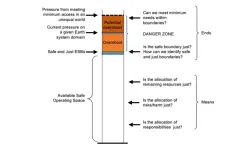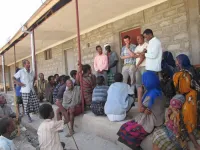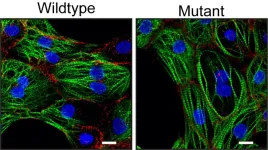(Press-News.org) Human noroviruses are the leading cause of acute gastroenteritis worldwide, a major global health problem for which there are no specific treatments or vaccines. Understanding the first phase of infection – the process the virus follows to invade cells – is a decisive step in the development of effective preventive and therapeutic strategies. A team led by researchers at Baylor College of Medicine is making strides in that direction.
The researchers report in the journal Nature Communications that the globally dominant human norovirus GII.4 strain invades gastrointestinal cells via an unexpected mechanism. The viral strategy involves interactions between specific components on both viral and human cell surface proteins and activates mechanisms that destabilize the cell membrane. The findings provide insight into the viral infection process, highlighting unique pathways and targets for developing effective therapeutics.
“We focused our study in the human norovirus pandemic strain GII.4, the one responsible for causing most cases of gastroenteritis around the world,” said first author Dr. B. Vijayalakshmi Ayyar, senior staff scientist of molecular virology and microbiology in the lab of Dr. Mary K. Estes at Baylor.
Ayyar, Estes and their colleagues worked with human intestinal enteroids, a laboratory model of the human gastrointestinal tract that recapitulates its cellular complexity, diversity and physiology. Human enteroids mimic strain-specific host-virus infection patterns, making them an ideal system to dissect human norovirus infection, identify strain-specific growth requirements and develop and test treatments and vaccines.
“We discovered that the binding of human norovirus GII.4 to enteroid cells wounds the cells’ membranes, which in turn triggers a membrane repair mechanism to the injury site, activating another cellular pathway known as the CLIC pathway,” Ayyar said. “We observed crosstalk between CLIC-mediated internalization of viral particles and host repair mechanisms. We propose that these pathways could be manipulated to interfere with viral entry in human intestinal cells.”
“To our knowledge, this is a previously uncharacterized complex entry process into human enteroids that combines several independent pathways. There may be more molecules involved in this entry pathway than what have been reported for other viruses,” said Estes, Distinguished Service Professor and Cullen Foundation Endowed Chair of molecular virology and microbiology at Baylor. Estes also is the corresponding author of the work. “Other viruses use some components of the pathways mentioned in our paper, but this is the first time a virus has been shown to use all of them together. We now are interested in figuring out the role each of these molecules plays in this novel, interesting process, and whether it relates to the pandemic nature of GII.4.”
The team also discovered novel aspects of how the virus itself participates in the entry process.
“We know the virus structure is organized into two domains or parts, a shell domain and a protruding domain,” Ayyar said. “Previously, we thought that all the interactions between the virus and cells involved only the protruding domain. In this work, we found that both the protruding and the shell domains are involved in the entry process. This suggests that virus interactions with cells cause changes in the viral structure that facilitate the cell entry. We also are interested in further exploring how these structural changes are induced and their precise role in the viral entry process.”
Other contributors to this work include Khalil Ettayebi, Wilhelm Salmen, Umesh C. Karandikar, Frederick H. Neill, Victoria R. Tenge, Sue E. Crawford, Erhard Bieberich, B. V. Venkataram Prasad and Robert L. Atmar.
This research was supported by National Institutes of Health grants P01 AI57788, P30DK56338 that supports the Texas Medical Center Digestive Diseases Center and the Texas Children’s Hospital EM core, T32 AI055413, S10 OD028480 that supported purchasing the Zeiss Laser Scanning Microscope LSM 980 with Airyscan 2 and the RobertWelch Foundation Q1279. The authors would like to acknowledge the Advanced Technology Core Laboratories at Baylor College of Medicine, specifically the Integrated Microscopy Core with funding from the NIH (DK56338, CA125123, ES030285) and CPRIT (RP150578, RP170719).
END
Human norovirus GII.4 exploits unexpected entry mechanism to cause gastroenteritis
2023-03-02
ELSE PRESS RELEASES FROM THIS DATE:
AI predicts cancer patient survival by reading doctor's notes
2023-03-02
A team of researchers from the University of British Columbia and BC Cancer have developed an artificial intelligence (AI) model that predicts cancer patient survival more accurately and with more readily available data than previous tools.
The model uses natural language processing (NLP) – a branch of AI that understands complex human language – to analyze oncologist notes following a patient’s initial consultation visit—the first step in the cancer journey after diagnosis. By identifying characteristics unique to each ...
For older adults, every 500 additional steps taken daily associated with lower heart risk
2023-03-02
Research Highlights:
A study of people ages 70 and older found walking an additional 500 steps per day, or an additional quarter mile of walking, was associated with a 14% lower risk of heart disease, stroke or heart failure.
Compared to adults who took less than 2,000 steps per day, adults who took about 4,500 steps per day had a 77% lower observed risk of experiencing a cardiovascular event.
Only about 3.5% of participants who took around 4,500 steps per day had a cardiovascular event, compared to 11.5% of those who took less than 2,000 steps per day, over the 3.5-year follow-up period.
Embargoed until 10:45 a.m. CT/11:45 a.m. ET, ...
American Society for Metabolic and Bariatric Surgery supports new clinical guidance on treatment of obesity in children and teens
2023-03-02
The American Society for Metabolic and Bariatric Surgery (ASMBS) fully supports the new “Clinical Practice Guideline for the Evaluation and Treatment of Children and Adolescents With Obesity” issued from the American Academy of Pediatrics (AAP) calling for earlier and more intensive treatment of obesity in children and teens. Published in the journal Pediatrics in February, this is the first comprehensive guideline on obesity in 15 years from the AAP, the largest professional association of pediatricians in the U.S.
According to AAP, more evidence ...
Many firearm owners in the U.S. store at least one gun unlocked, fearing an emergency
2023-03-02
Most firearm owners keep at least one firearm unlocked, with some viewing gun locks as an unnecessary obstacle to quick access in an emergency, according to a Rutgers study. But when they do lock their firearms, Rutgers researchers found that firearm owners are most likely to use gun safes.
In a study published in JAMA Network Open and funded by the Defense Health Agency, researchers surveyed a national sample of 2,152 English-speaking adult firearm owners, asking them what locking devices they used and why.
Unlike previous studies, participants were presented with both words and images describing each ...
To ensure a safe and just future for people, nature and the planet, Earth System Boundaries must include justice, researchers find
2023-03-02
In a new study published in Nature Sustainability an international team of scientists from the Earth Commission, convened by Future Earth, investigates how global biophysical boundaries need to be adjusted to ensure a safe and just future for people, nature and the planet. The Earth Commission is the scientific cornerstone of the Global Commons Alliance
This new framework integrates methods to reduce harm to people, increase access to resources, address tradeoffs, and challenge powerful interests whilst addressing inequality between generations and between humans and nature ...
Genomic study of indigenous Africans paints complex picture of human origins and local adaptation
2023-03-02
Africa, where humans first evolved, today remains a place of remarkable diversity. Diving into that variation, a new analysis of 180 indigenous Africans from a dozen ethnically, culturally, geographically, and linguistically varied populations by an international scientific team offers new insights into human history and biology, and may inform precision medicine approaches of the future.
The work clarifies human migration histories, both historical and more recent, and provides genetic evidence of adaptation to local environments, ...
Energy: More than two million citizens power Europe’s renewable energy transition
2023-03-02
More than two million citizens across 30 European countries have been involved in thousands of projects and initiatives as part of efforts to transition to renewable energy, according to an analysis published in Scientific Reports. With investments ranging between 6.2 and 11.3 billion Euros, these findings highlight the important role of collective action in the decarbonisation of Europe.
The energy system in Europe is undergoing a significant transition towards renewables and decarbonisation. However, the contribution ...
Performance of outpatient surgical procedures before, after onset of pandemic
2023-03-02
About The Study: The findings of this study suggest that despite calls for the expansion of outpatient surgery to mitigate the growing backlog of surgical cases in the wake of the COVID-19 pandemic, uptake of this practice occurred in only a small subset of operations. Further studies should explore potential barriers to the uptake of this approach, particularly for procedures that have been shown to be safe when performed in an outpatient setting.
Authors: Cornelius A. Thiels, D.O., M.B.A., of the Mayo Clinic in Rochester, Minnesota, is the corresponding author
To access the embargoed study: Visit our For The Media website at this link https://media.jamanetwork.com/
(doi:10.1001/jamanetworkopen.2023.1198)
Editor’s ...
Trends, variation in the use of active surveillance for management of low-risk prostate cancer
2023-03-02
About The Study: The results of this study of more than 20,000 men with low-risk prostate cancer suggest that active surveillance rates are rising nationally but are still suboptimal, and wide variation persists across practices and practitioners. Continued progress on this critical quality indicator is essential to minimize overtreatment of low-risk prostate cancer and by extension to improve the benefit-to-harm ratio of national prostate cancer early detection efforts.
Authors: Matthew R. Cooperberg, M.D., M.P.H., of the UCSF Helen Diller Family Comprehensive Cancer Center in San Francisco, is the corresponding ...
New mutation in the desmoplakin gene leads to ACM
2023-03-02
Researchers from the group of Eva van Rooij in collaboration with the UMC Utrecht identified a new mutation that leads to the cardiac disease arrhythmogenic cardiomyopathy (ACM). They assessed the effect of this mutation on heart muscle cells and obtained new insights into the underlying mechanism that causes the disease. The results of this study, published on March 2nd in Stem Cell Reports, could contribute to the development of new treatments for ACM.
Desmosomes
Millions of heart muscle cells contract to let the heart fulfill ...


